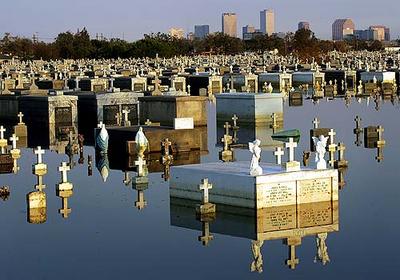Scientists Try to Identify Bodies in La.

By DOUG SIMPSON
Associated Press Writer
October 14, 2005, 4:55 PM EDT
DELCAMBRE, La. -- First the floodwaters dislodged massive burial vaults from the earth. Then the vaults yawned open, and out floated hundreds of coffins. And when the coffins opened, their contents drifted away, too.
Along with the despair they brought to the living, Hurricanes Katrina and Rita also evicted the dead from what were supposed to be their final resting places, scattering skeletal remains across the region in a ghastly spectacle.
Now forensic anthropologists are busy trying to identify the remains and return them to their graves, some of which date to the 19th century.
In Delcambre, a small town about 125 miles west of New Orleans, people who evacuated to escape Rita returned to find caskets and tombs on sidewalks and on top of trucks.
"You come home and see coffins in the road, tombs in the road. It was crazy," said Sylvester Harris, who lives across the street from a Roman Catholic cemetery.
In all, the state health department said it has learned of about 1,000 coffins dislodged by the storms, not all of them found yet.
"I'm assuming we'll find some up in the backwoods, pretty far from where they belong," Dr. Louis Cataldie, a health department physician leading the recovery and identification effort.
Every parish along Louisiana's coast has reported burial vaults picked up and moved by storm waters, either after Katrina hit Aug. 29, or after Rita struck on Sept. 24, Cataldie said.
In Louisa, a remote community near the Gulf Coast, small St. Helen's Cemetery was among the hardest hit: About 60 tombs were pulled from their plots, Sheriff David Naquin said. About a dozen blocked a highway before they were moved by sheriff's deputies.
The coroner and morticians are working to match the vaults and coffins with their burial plots.
"It's like putting a jigsaw puzzle together," Naquin said. "We still have some pieces missing."
Coffins in southern Louisiana are traditionally placed inside massive concrete vaults, which often are set only a foot or two into the earth -- partly because coastal towns are on marshy land only a few feet above sea level. Spouses often purchase double vaults: If the husband is buried first, the lid of the vault can later be lifted and the wife's coffin set alongside.
Hurricane Rita brought a powerful storm surge of up to 9 feet to Louisiana, forcing vaults out of the ground and pulling their lids. Naquin said several vaults weighing an estimated 600 pounds were found nearly a half-mile from St. Helen's Cemetery.
His deputies gathered up skeletal remains and handed them over to the parish coroner.
"It wasn't fun, I can tell you," Naquin said.
The remains are being analyzed at the same morgue set up in the town of St. Gabriel to handle the corpses of the more than 1,000 people killed by Katrina.
"A lot of these folks have been casketed for a long time, so we've only got bones to deal with," Cataldie said. "Evidently, it's not mandatory to place identification inside the casket, which was news to me. That's not helping."
The anthropologists are looking for such things as identifying pieces of jewelry and are also taking X-rays, examining the teeth and extracting DNA in hopes of putting names on the dead.
Link Here




0 Comments:
Post a Comment
<< Home